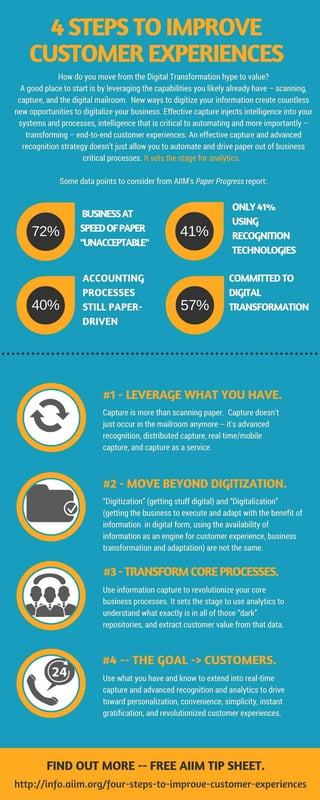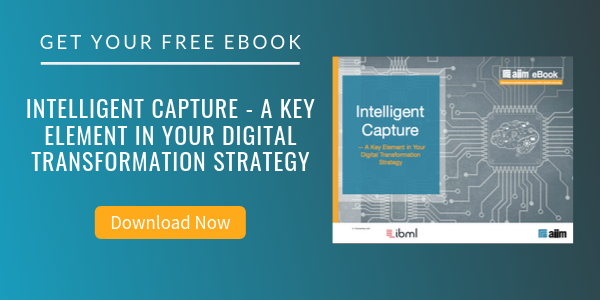
An Information Professional's Guide to Improving Customer Experience
Business Process Management (BPM) | Capture and Imaging | Digital Transformation
Digital Disruption. Digital Experiences. They are on the wish list for just about every C-level executive. But where do you start? How do you move from the hype to value? A good place to start is by leveraging the capabilities you likely already have – scanning, capture, and the digital mailroom – and extending them into the core processes that you use to run your business.
Here are 4 steps to insure success:
1. Leverage what you already have as a starting point on the Transformation journey.
Capture is a proven first step in digitizing information. According to AIIM’s Paper-free Progress: Measuring Outcomes organizations say, “We are committed to digital transformation, and paper-free is an essential starting point.”
Amplifying this a bit, 80% of organizations agree that, “Paper content and processes are a huge impediment to remote access and telework,” and 72% add, “Business at the speed of paper will be unacceptable in a few years’ time.”
So as you think about how you might leverage some of your existing capture investments, consider that capture is more than scanning paper. Capture is more than paper. Consider PDF conversion ... email imports ... back-file conversion ... mobile – all of these can be leveraged from your existing capture investment. Organizations need to move toward a concept of “capture” in which “digital intelligence” is built in rather than bolted on.
2. Move from Digitization only to Digitalization of your business.
An important distinction: “Digitization” (getting stuff digital) and “Digitalization” (getting the business to execute and adapt with the benefit of information in digital form, using the availability of information as an engine for customer experience, business transformation and adaptation) are not the same.
Regarding Digitization, most organizations are just scratching the surface of what they COULD do with capture. 34% scan flat images only – 16% for workflow and 18% for archive. For most, it’s still a scan to archive game – a rush to essentially eliminate physical storage.
Regarding Digitalization, only 41% are using OCR in some form, with 23% capturing process data. Only 9% are using this data for intelligent or adaptive workflows to optimize complex case management.
Even with so much past focus on Digitization only, capture ROI is impressive and can be used to fund other initiatives. 59% of our users achieved payback in 12 months or less (a single budget cycle) including 28% seeing positive returns after just 6 months. Capture ROI accelerates with push to Digitalization.
The REAL key to enhanced ROI – push the technology beyond what you are currently doing both in terms of recognition and where and how capture is done. Advanced Recognition provides the most solid ROI and proves that capture provides the strongest ROI of any area within ECM. Capture doesn’t just occur in the mailroom anymore. It occurs as distributed capture, real time/mobile capture and capture as a service.
3. Start by Transforming Core Business Processes
Use information capture to revolutionize your core business processes – a necessary (but not sufficient!) condition for Digital Transformation.
Most organizations have not applied the lessons from the digital mailroom to their core financial processes. According to an AIIM unreleased survey of 290 finance executives, there are a host of core process that are still clogged with paper. Here are the percentages of finance executives who agree with the statement, “A lot of documents are processes as paper documents” in a series of core finance processes.
- Accounts receivable = 38%
- Financial close process = 40%
- Accounts payable = 39%
- Procurement and purchasing = 32% § Vendor management = 32%
You can find just about the same story in every other core business process, whether it’s HR, contracts administration, sales, marketing – take your pick. As organizations think about how to automate these processes, two things become increasingly apparent. (1) Real-time capture and user experience are critical; and (2) An effective capture and advanced recognition strategy doesn’t just allow you to automate and drive paper out of business critical processes. It sets the stage to use analytics to understand what exactly is in all of those “dark” repositories, and extract customer value from that data.
4. Focus on Transforming Customer Experiences
Mobile, Distributed, SaaS-based capture – real-time capture – bring capture closer to the customer and engaging the customer. New ways to digitize your information create countless new opportunities to digitalize your business. Effective capture injects intelligence into your ECM systems and processes – intelligence that is critical to automating and more importantly – transforming -- end-to-end customer experiences. An effective capture and advanced recognition strategy doesn’t just allow you to automate and drive paper out of business critical processes. It sets the stage for analytics.
Revolutionizing customer experiences carries these benefits to companies:
- Geographic and customer segment reach
- Business Agility
- Efficient/effective back office processes
- Digital Insights
- Business model flexibility
- Cost reduction
Turning to the customer side, revolutionizing customer experiences carries these benefits:
- Personalization and convenience
- Simplicity, instant gratification
- Streamlining and automation – have to do less steps as customer
- Lower cost with more choices
- Buy only what you use
- Social buying and trusted social networks.
[Infographic] 4 Steps to Improve Customer Experiences
We've summarized the four steps above into a handy infographic to make them easy to remember and share.
Leveraging Technology You Already Have to Create True Digital Experiences
We dove a bit deeper into this topic on a recent webinar. If you want to learn more about how you, as an information professional, play an essential role in improving customer experience, check out these slides.
About John Mancini
John Mancini is the President of Content Results, LLC and the Past President of AIIM. He is a well-known author, speaker, and advisor on information management, digital transformation and intelligent automation. John is a frequent keynote speaker and author of more than 30 eBooks on a variety of topics. He can be found on Twitter, LinkedIn and Facebook as jmancini77. Recent keynote topics include: The Stairway to Digital Transformation Navigating Disruptive Waters — 4 Things You Need to Know to Build Your Digital Transformation Strategy Getting Ahead of the Digital Transformation Curve Viewing Information Management Through a New Lens Digital Disruption: 6 Strategies to Avoid Being “Blockbustered” Specialties: Keynote speaker and writer on AI, RPA, intelligent Information Management, Intelligent Automation and Digital Transformation. Consensus-building with Boards to create strategic focus, action, and accountability. Extensive public speaking and public relations work Conversant and experienced in major technology issues and trends. Expert on inbound and content marketing, particularly in an association environment and on the Hubspot platform. John is a Phi Beta Kappa graduate of the College of William and Mary, and holds an M.A. in Public Policy from the Woodrow Wilson School at Princeton University.




